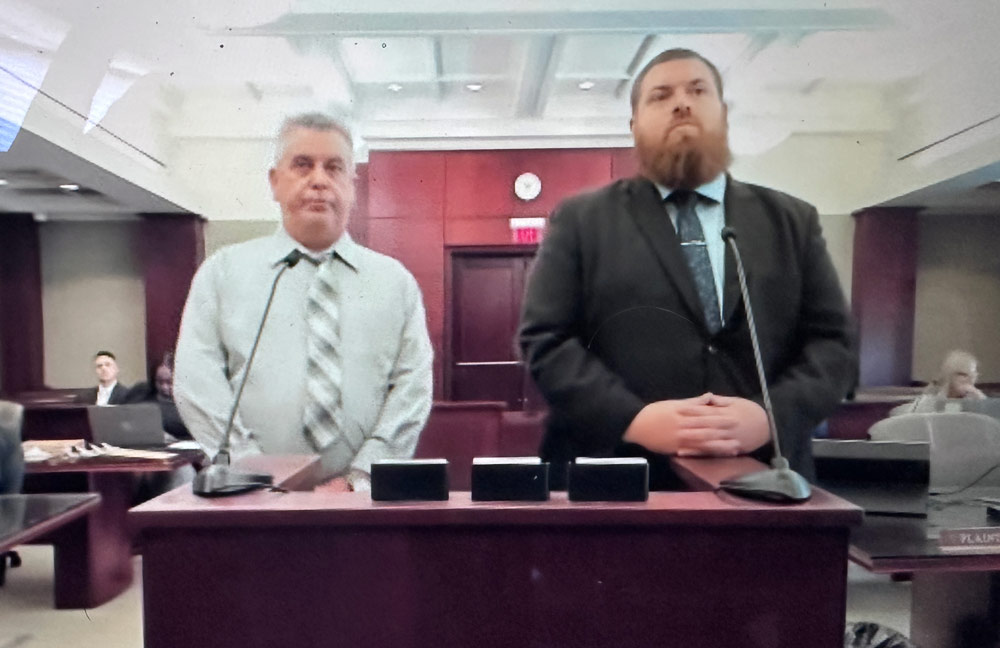
Joao Fernandes was adamant. He wanted his trial.
He’d been willing to serve a single year on probation–an admission of guilt for his hit and run that left a 25-year-old motorcyclist a heap of broken bones–but nothing more. His attorney, Brian Penney, seemed as convinced as his client. Fernandes turned down an offer of serving one year in prison. Circuit Judge Dawn Nichols told them their idea of a settlement was “offensive to the state.”
Dismayed at their seeming intransigence in the face of substantial evidence against Fernandes, the judge tried to convince both to “see the forest for the trees” in a hearing on Wednesday. She evaluated the evidence for them. She all but predicted an unhappy outcome. It was in vain.
She finally threw up her hands and scheduled a trial for July. If found guilty. Fernandes, a 50-year-old resident of Palm Coast’s P Section, would face up to 15 years in prison, a mandatory minimum of three, and a likely demand from Assistant State Attorney Tara Libby for more than that, as the judge warned him.
All from a split-second collision in what may have been a temperamental fog at 10 p.m. the night of last August 28 on Belle Terre Parkway.
Tristen Tyler Thompson was on a motorcycle, one of several in a group traveling south. They were approaching the intersection of Whipoorwill Drive. A witness told a Flagler County Sheriff’s deputy investigating the crash that he’d seen several motorcyclists and a black pick-up truck behind them. The truck, according to a sheriff’s report, “went to make a U-turn, but did not.” Instead, the truck sped up to follow the motorcycles, hit one of them, and sped off. Bunnell police later located the pick-up truck and pulled over Fernandes for speeding. (He was cited for leaving the scene, not for speeding.)
Fernandes told the deputy that a group of motorcyclists were riding erratically while he was behind them, swerving and cutting people off in traffic. The motorcyclist slowed down when another motorcyclist allegedly swerved into his lane. Fernandes wasn’t sure if there’d been a collision. But he drove on. He was charged with leaving the scene of a crash with an injury, a second-degree felony.
Thompson was left in the grass by the road. According to Libby, he had a broken leg she described as a “traumatic displaced fracture,” multiple broken ribs, a fracture of the right hand, a compression fracture of the vertebrae, and a punctured lung. He has recovered, but has not been working since.
“We are ready for trial,” Penney told the court, explaining that depositions were more helpful to his case than medical records. “The medical records were more just to see if there was anything potentially in the alleged victim’s system that might have contributed,” he said. “The depositions were a little bit more fruitful than the medical records were. So I believe we got some good testimony from the depositions.”
The state had offered a 366-day sentence, meaning one day more than what would have been a jail sentence. At 366 days, Fernandes would have to serve his time in state prison, though with gain time, or time off for good behavior, he would end up serving closer to 311 days.
He turned down the offer. He is unwilling to serve time.
“We had countered after the depositions, because we believe that it boosted what the defense’s theory was, and the state indicated that we were just too far apart,” Penney said. “He’s got no priors before, he’s got a clean driving record.” The defense claims there have been inconsistent statements in the case, though it’s rare, in cases relying on witnesses, where the defense would not at one point or another claim inconsistency.
Libby scoffed at the claim. “Mr. Penney says that there’s inconsistent statements,” Libby told the court. “There’s not inconsistent statements as to what the independent witness saw, the amount of injuries, or the damage to Mr. Fernandes’s vehicle. So to come back with an adjudication to a reckless driving and 12 months of probation–that’s not a counter-offer. I’m sorry. It’s really not.”
The attorneys then essentially previewed the trial ahead, enabling the judge to imagine how the jury will read the case.
“This isn’t your normal hit and run where there’s like a head-on collision, it’s clear,” Penney said. “The alleged victim admitted to being in the defendant’s blind spot. It’s dark, it’s a lifted truck. There’s a lot of noises. The other party that was with the alleged victim admits to swinging and possibly making contact with the defendant’s mirror, which is what the defendant was under the impression [was] happening, as well as the inconsistent testimony identified.”
According to Penney, one of the witnesses described the truck as gray, not black. Another witness said the front of the truck hit the victim, while the victim said he was in Fernandes’s blind spot, and “the damage to the truck is also inconsistent,” Penney said. “One, there’s one little mark on the blind spot, but the officer marked that there was damage on the front, which is inconsistent where the victim said he did.”
Juries and prosecutors typically focus on physical evidence ahead of witness statements, since witness statements in the heat of the moment can be less reliable, while physical evidence is neutral and remains unchanged. The judge tried to make Penney understand.
“That’s an awful of what if’s,” Nichols told him. “You’re going to have six jurors sitting there, and that counteroffer is–and you’ve been doing this a long time–that is offensive to the state.”
Penney said he understood, but was unmoved.
“What I want to impress upon Mr. Fernandes, who has no prior history,” Nichols said as Fernandes stood next to his attorney at a lectern a few feer in front of the judge, “if he goes to trial and loses, his exposure is up to 15 years in state prison. I’m not talking Flagler County jail. I’m talking Department of Corrections. And for somebody who’s never been to prison before, that counteroffer based just upon what I’ve heard, and the facts I read about in the case–and of course, I’m neutral–that’s a mighty big gamble to take. If he’s found guilty, I can’t downward depart” (meaning the judge can’t go lower than the minimum mandatory sentence in the guidelines), “and Ms. Libby’s not going to ask for three years. She’s going to be asking for more than three years. So that 366 offer is looking pretty darn good.”
The judge said the case has all the makings of a resolution, even if the two sides agreed to a range, leaving her–the judge–to decide the sentence. “Because if he’s found guilty, and I don’t have the ability [to lower the sentence], he’s going away for three years up to 15,” Nichols said. “I’m not saying I would sentence him to 15. But he’s going to prison. And so this is something that, oh, you’re ready for trial, and oh, there are a few inconsistencies here, and you spinning it in the light that you spun it, I’m still not all that impressed. This is not a slam dunk.”
Nichols told the defense attorney of the two independent witnesses who were not in Fernandes’s vehicle. Penney kept countering about their “inconsistent statements” as to where the collision occurred.
“Oh, Mr. Penney,” a disbelieving judge told him, “I go home at the end of the day. If he wants his trial, that’s fine. But I think that one, your counteroffer was woefully inadequate, and I just want him to have realistic expectations, because I don’t know that those inconsistencies are going to save the day. And if he’s found guilty, he’s going to be leaving through that door in handcuffs.” She indicated the side door in the courtroom where inmates are guarded in and out.
Then she asked Fernandes if he was understanding the discussion.
“I understand. Yeah. I understand,” he said.
“You fully want to go to trial?”
“We’re going to trial,” Fernandes said with finality, professing his innocence.
“Okay,” the judge said. “I’m ordering jurors on this one.” Docket sounding is set for July 9. Libby is expecting a two-day trial aside from jury selection. The judge doesn’t think it’ll take three days.
Penney said he would meet with Fernandes again to talk about a settlement, but couldn’t count on it if Fernandes doesn’t want to change his mind.
“Listen Mr. Penney,” the judge said, “I’ve practiced law for 20 years, and I had some clients that just, even though they paid me good money for my advice, didn’t always listen to it. So I absolutely understand.”
Fernandes on Wednesday got the paid advice of his attorney, and the free advice from a judge and former attorney with a combined 31 years’ experience–and the recent experience with Flagler County juries that on several occasions sent defendants to life in prison after they’d turned down more forgiving offers, and rejected the judge’s advice. He left the courtroom a relatively free man, as he’s been out on $2,500 bond since the day after the crash.
He also faces a civil suit from Thompson, who is seeking damages in excess of $50,000. The lawsuit is in the deposition phase.






























DaleL says
The motorcyclist, Thompson, is described as having suffered a broken leg (“traumatic displaced fracture”), multiple broken ribs, a fracture of the right hand, a compression fracture of the vertebrae, and a punctured lung. I think that because of that amount of trauma that any testimony from the motorcyclist is questionable. The physical evidence should be the most persuasive. The fact that the defendant has a lifted truck, which might make it difficult to drive safely in those conditions, is not an alibi or excuse.
Many drivers today use dash cams to document any road incidents. My elderly neighbor uses a dash cam on every drive. Tesla vehicles have the ability to record video streams from their multiple cameras that will document any crash or incident. It just requires a USB fob in the glove box and enabling the feature. If Mr. Fernandes is as innocent as he claims, he should consider having and using a dash cam in the future.
JimboXYZ says
While I feel for the motorcyclist & his injuries. If I were a juror, this part of the article is what I’d focus on ?
“Fernandes told the deputy that a group of motorcyclists were riding erratically while he was behind them, swerving and cutting people off in traffic. The motorcyclist slowed down when another motorcyclist allegedly swerved into his lane. Fernandes wasn’t sure if there’d been a collision. But he drove on. He was charged with leaving the scene of a crash with an injury, a second-degree felony.”
I’ve witnessed motorcyclist driving like this on Belle Terre on more than one occasion. Even been the victim of several bikers that have cut me off. A more recent one the offending biker had arguably the ugliest woman I’ve ever seen in Flagler county, she flipped me off while her BF/husband was cutting me off. I have thick skin, I didn’t take it personal, braked to allow the 2 village idiots that illegal lane change. An altercation with that level of stupid is a waste of anyone’s time.
When one doesn’t yield the right of way for another being in a lane. I can have all the compassion in the world for the biker & severity of the injuries, but it still doesn’t change the fact that it was the biker that initiated a situation as self inflicted. I’d have to also know whether the truck was lifted to exceed the legal height allowable by statute. If there’s any doubt as to whether there’s a conflict to change a lane by bikers, they need to make sure there isn’t a vehicle in that lane and they need to signal their turn. I just have witnessed too many bikers over a lifetime that drive in a pack and use the pack mentality to commandeer a lane that is inconsistent & a clear violation of FL Statute. I don’t care if they’re bar hopping or doing some non-sanctioned by law enforcement charity run . Those laws apply and if they can’t operate their motorcycles in accordance with FL Statute, individual or as a pack. Maybe they should consider alternate means of commuting for transportation ? “Ride to Live” might be more applicable here. That’s if what Fernandes maintains happened, did indeed happen. From the inconsistencies & the motorcyclists admits they were in the motorists blind spot.
I think if the State presents this as cut & dried, that Fernandes left the scene, that much is clear cut. There was contact, he did drive away. But if the contact happened for an illegal lane change. in this case a swerve that was unavoidable. I couldn’t find against the motorist that had right of way for that lane. Stay clear of a vehicle that has right of way is that hard lesson in life.
Concerned citizen says
Flagler county court system is not justice, Paul is willing to accept a years probation for this is more then fair . He’s giving the state something when the state shouldn’t even being eating tax payers money on this. It’s called an accident, a big lifted truck a motorcycle hit in blind spot. Paul has no criminal record. Clean driving record.
And the state is calling for prison time? Seriously? Where is the justice here?